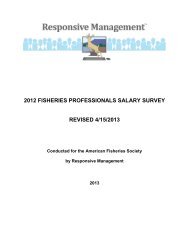Conservation Status of Crayfish Species Paddlefish Conservation ...
Conservation Status of Crayfish Species Paddlefish Conservation ...
Conservation Status of Crayfish Species Paddlefish Conservation ...
You also want an ePaper? Increase the reach of your titles
YUMPU automatically turns print PDFs into web optimized ePapers that Google loves.
native ranges, we use the g or global scale<br />
for conservation status rankings. Categories<br />
follow Master (1991) and are defined as<br />
follows: g1 = critically imperiled, g2 =<br />
imperiled, g3 = vulnerable to extirpation<br />
or extinction, g4 = apparently secure, g5<br />
= demonstrably widespread, abundant, and<br />
secure, gH = possibly extinct, known only<br />
from historical collections, and gX = presumed<br />
extinct.<br />
LiSt OF taXa (appendiX 1)<br />
The list <strong>of</strong> crayfish species and subspecies<br />
is arranged alphabetically by genus<br />
and by species and subspecies within the<br />
genus. Following the scientific name and<br />
author(s), the common name is followed by<br />
assigned conservation status using a letter<br />
code: e = Endangered; e* = Endangered,<br />
Possibly Extinct; t = Threatened; V<br />
= Vulnerable; CS = Currently Stable.<br />
Criteria used to determine conservation<br />
statuses are indicated by numerals 1<br />
through 5 and correspond to those defined<br />
in Methods. global Heritage ranks (see<br />
Methods) immediately follow listing criteria.<br />
A dagger denotes a species complex<br />
currently under taxonomic investigation.<br />
Finally, the distribution <strong>of</strong> each taxon is<br />
indicated by an alphabetical listing <strong>of</strong> U. S.<br />
states and Canadian provinces where that<br />
taxon occurs. Parentheses around states<br />
indicate known or suspected introductions.<br />
Standard two-letter abbreviations<br />
for states and provinces follow Williams et<br />
al. (1989).<br />
SummarY and COnCLuSiOnS<br />
The list <strong>of</strong> crayfishes <strong>of</strong> the United<br />
States and Canada includes 363 taxa.<br />
Possibly Extinct, Endangered, Threatened,<br />
or Vulnerable statuses are recognized for<br />
The digger crayfish (Fallicambarus fodiens) is<br />
one <strong>of</strong> the most widespread crayfish species in<br />
North America. It occurs from ontario, canada<br />
to Texas.<br />
photo by c. Taylor.<br />
174 taxa (47.9%). Of these, 2 (< 1%)<br />
are possibly Extinct, 66 (18.2%) are<br />
Endangered, 52 (14.3%) are Threatened,<br />
and 54 (14.9%) are Vulnerable. Taxa classified<br />
as currently stable total 189 (52.1%).<br />
The number <strong>of</strong> imperiled crayfishes (48%)<br />
parallels the high levels <strong>of</strong> imperilment <strong>of</strong><br />
fishes and freshwater mussels, almost 33%<br />
and 72%, respectively (Williams et al.<br />
1989; Williams et al. 1993; Warren and<br />
Burr 1994). These assessments support the<br />
contention that aquatic diversity in North<br />
America is in far worse condition than<br />
its terrestrial counterpart (Master 1990,<br />
Master et al. 2000).<br />
For some crayfishes, limited natural<br />
range (e.g., one locality or one drainage<br />
system) precipitates recognition as<br />
Endangered or Threatened; but for many<br />
others, status assignments continue to be<br />
hampered by a paucity <strong>of</strong> recent distributional<br />
information. While progress has<br />
been made in this arena, basic ecological<br />
and current distributional information are<br />
lacking for 60% <strong>of</strong> the U.S. and Canadian<br />
fauna. In addition, threats highlighted<br />
by Taylor et al. (1996) such as habitat<br />
loss and the introduction <strong>of</strong> nonindigenous<br />
crayfishes continue to persist and<br />
are greatly magnified by the limited distributions<br />
<strong>of</strong> many species. The threat <strong>of</strong><br />
nonindigenous species has even increased<br />
(Lodge et al. 2000; Flinders and Magoulick<br />
2005) due to actual introductions and<br />
emerging conduits for potential introductions.<br />
As stated by Taylor et al. (1996),<br />
lack <strong>of</strong> recent species-specific information,<br />
whether distributional or biological, does<br />
not warrant neglect by resource agencies.<br />
Recognition <strong>of</strong> the potential for rapid decimation<br />
<strong>of</strong> crayfish species, especially those<br />
with limited ranges, should provide impetus<br />
for proactive efforts toward conserva-<br />
While generally inhabiting lentic habitats, a<br />
few members <strong>of</strong> the genus Procambarus, such<br />
as P. lophotus shown here, can occur in high<br />
gradient streams.<br />
photo by G. Schuster.<br />
tion as espoused by the American Fisheries<br />
Society (Angermeier and Williams 1994).<br />
In publishing this list, the American<br />
Fisheries Society Endangered <strong>Species</strong><br />
Committee summarizes for fisheries pr<strong>of</strong>essionals,<br />
natural resource agencies,<br />
university researchers, conservation organizations,<br />
lawmakers, and citizens, the<br />
conservation status <strong>of</strong> crayfishes in the<br />
United States and Canada. The results<br />
<strong>of</strong> this reassessment provide some signs <strong>of</strong><br />
improvement in the recognition <strong>of</strong> crayfish<br />
conservation. Because the number <strong>of</strong> crayfish<br />
taxa in need <strong>of</strong> conservation attention<br />
has changed little, suggested actions for<br />
natural resource personnel mirror those<br />
proposed by Taylor et al. (1996). These<br />
include, but are not limited to: (1) critically<br />
examine the findings <strong>of</strong> this reassessment<br />
and bring to our attention additional<br />
information; (2) use the list as a planning<br />
and prioritization tool for conducting<br />
recovery efforts, status surveys, and biological<br />
research on imperiled crayfishes;<br />
(3) support graduate research and training<br />
in the distribution, taxonomy, and ecology<br />
<strong>of</strong> crayfishes; (4) propagate education<br />
<strong>of</strong> citizens; and (5) recognize the plight <strong>of</strong><br />
aquatic resources and act accordingly and<br />
proactively.<br />
additiOnaL inFOrmatiOn<br />
We provide this section to aid the<br />
reader in accessing additional information<br />
on crayfishes <strong>of</strong> the United States<br />
and Canada. The papers and Internet<br />
resources, organized alphabetically by state,<br />
are primarily taxonomic or distributional<br />
in nature but also cover topics associated<br />
with a variety <strong>of</strong> aspects <strong>of</strong> the biology <strong>of</strong><br />
crayfishes. Additional crayfish information<br />
can also be found by following links found<br />
on some <strong>of</strong> the websites listed below.<br />
The signal crayfish (Pacifastacus leniusculus<br />
leniusculus) is a widespread species found<br />
in the pacific Northwest and is harvested for<br />
human consumption in parts <strong>of</strong> its range.<br />
photo by c. Taylor.<br />
Fisheries • vol 32 no 8 • august 2007 • www.fisheries.org 377







